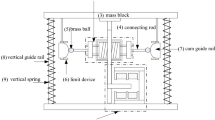Abstract
In the paper, a novel passive vibration isolator is proposed for an ultra-precision sensing system, utilizing a quasi-zero stiffness (QZS) mechanism. The QZS mechanism implements the high static low dynamic stiffness, which effectively reduces the dynamic force transmission while minimizing the static deflection under the natural frequency of conventional passive isolator. Furthermore, it does not need any electric components; the mechanism is suitable for the ultra-precision sensing systems measuring extremely weak electromagnetic fields. However, nonlinear stiffness and hysteresis caused from the negative stiffness elements degrade the system performance. A vertical spring with a pre-tension and eight horizontal plate springs with nonlinear buckling characteristics constitute the proposed system to solve these problems. The mathematical model compares the negative stiffness design with previous QZS research. The buckled plate spring with ball joint design reduces stiffness variation. Transmissibility of the proposed system for low frequency range is investigated experimentally.








Similar content being viewed by others
References
Griggs, C., Moody, M., Norton, R., Paik, H., & Venkateswara, K. (2017). Sensitive superconducting gravity gradiometer constructed with levitated test masses. Physical Review Applied, 8(6), 064024.
Van Trung, P., Kim, K.-R., & Ahn, H.-J. (2013). A nonlinear control of an QZS isolator with flexures based on a lyapunov function. International Journal of Precision Engineering Manufacturing, 14(6), 919–924.
Turnip, A., Park, S., & Hong, K.-S. (2010). Sensitivity control of a MR-damper semi-active suspension. International Journal of Precision Engineering, 11(2), 209–218.
Ibrahim, R. (2008). Recent advances in nonlinear passive vibration isolators. Journal of sound vibration, 314(3–5), 371–452.
Lee, J.-H., & Kim, K.-J. (2007). Modeling of nonlinear complex stiffness of dual-chamber pneumatic spring for precision vibration isolations. Journal of sound vibration, 301(3–5), 909–926.
Johnson, C. D., Wilke, P. S., & Darling, K. R. Multi-axis whole-spacecraft vibration isolation for small launch vehicles. In Smart Structures and Materials 2001: Damping and Isolation, 2001 (Vol. 4331, pp. 153–162): International Society for Optics and Photonics.
Le, T. D., & Ahn, K. K. (2011). A vibration isolation system in low frequency excitation region using negative stiffness structure for vehicle seat. Journal of Sound Vibration, 330(26), 6311–6335.
Xu, D., Yu, Q., Zhou, J., & Bishop, S. (2013). Theoretical and experimental analyses of a nonlinear magnetic vibration isolator with quasi-zero-stiffness characteristic. Journal of Sound Vibration, 332(14), 3377–3389.
Shin, K. (2014). On the performance of a single degree-of-freedom high-static-low-dynamic stiffness magnetic vibration isolator. International Journal of Precision Engineering Manufacturing, 15(3), 439–445. https://doi.org/10.1007/s12541-014-0355-4.
Lan, C.-C., Yang, S.-A., & Wu, Y.-S. (2014). Design and experiment of a compact quasi-zero-stiffness isolator capable of a wide range of loads. Journal of Sound and Vibration, 333(20), 4843–4858. https://doi.org/10.1016/j.jsv.2014.05.009.
Kim, K.-R., You, Y.-H., & Ahn, H.-J. (2013). Optimal design of a QZS isolator using flexures for a wide range of payload. International Journal of Precision Engineering Manufacturing, 14(6), 911–917. https://doi.org/10.1007/s12541-013-0120-0.
Wang, X., Zhou, J., Xu, D., Ouyang, H., & Duan, Y. (2017). Force transmissibility of a two-stage vibration isolation system with quasi-zero stiffness. Nonlinear Dynamics, 87(1), 633–646. https://doi.org/10.1007/s11071-016-3065-x.
Kovacic, I., Brennan, M. J., & Waters, T. P. (2008). A study of a nonlinear vibration isolator with a quasi-zero stiffness characteristic. Journal of Sound and Vibration, 315(3), 700–711. https://doi.org/10.1016/j.jsv.2007.12.019.
Carrella, A., Brennan, M. J., & Waters, T. P. (2007). Static analysis of a passive vibration isolator with quasi-zero-stiffness characteristic. Journal of Sound and Vibration, 301(3), 678–689. https://doi.org/10.1016/j.jsv.2006.10.011.
Ahn, H.-J. (2008). Performance limit of a passive vertical isolator using a negative stiffness mechanism. Journal of Mechanical Science Technology, 22(12), 2357. https://doi.org/10.1007/s12206-008-0930-7.
Huang, X., Chen, Y., Hua, H., Liu, X., & Zhang, Z. (2015). Shock isolation performance of a nonlinear isolator using Euler buckled beam as negative stiffness corrector: Theoretical and experimental study. Journal of Sound and Vibration, 345, 178–196. https://doi.org/10.1016/j.jsv.2015.02.001.
Liu, X., Huang, X., & Hua, H. (2013). On the characteristics of a quasi-zero stiffness isolator using Euler buckled beam as negative stiffness corrector. Journal of Sound and Vibration, 332(14), 3359–3376. https://doi.org/10.1016/j.jsv.2012.10.037.
Ledezma-Ramirez, D., Guzman-Nieto, M., Tapia-Gonzalez, P., & Ferguson, N. Shock isolation systems using non linear stiffness and damping. In International Conference on Noise and Vibration Engineering, 2014 (pp. 4111–4122).
Lang, R. F., & Seidel, W. (2009). Search for dark matter with CRESST. New Journal of Physics, 11(10), 105017.
Virgin, L. N., & Davis, R. B. (2003). Vibration isolation using buckled struts. Journal of Sound and Vibration, 260(5), 965–973. https://doi.org/10.1016/S0022-460X(02)01177-X.
Rao, S. S., & Yap, F. F. (2011). In M. J. Horton (Ed.), Mechanical vibrations (Vol. 4). Upper Saddle River: Prentice hall.
Bratosin, D., & Sireteanu, T. Hysteretic damping modelling by nonlinear Kelvin-Voigt model. In Romanian Academy–Series A: Mathematics, Physics, Technical Sciences, Information Science, 2002 (Vol. 3, pp. 99–104).
Acknowledgements
This research was supported by the Agency for Defense Development.
Author information
Authors and Affiliations
Corresponding authors
Additional information
Publisher's Note
Springer Nature remains neutral with regard to jurisdictional claims in published maps and institutional affiliations.
Rights and permissions
About this article
Cite this article
Kim, J., Jeon, Y., Um, S. et al. A Novel Passive Quasi-Zero Stiffness Isolator for Ultra-Precision Measurement Systems. Int. J. Precis. Eng. Manuf. 20, 1573–1580 (2019). https://doi.org/10.1007/s12541-019-00149-2
Received:
Revised:
Accepted:
Published:
Issue Date:
DOI: https://doi.org/10.1007/s12541-019-00149-2



